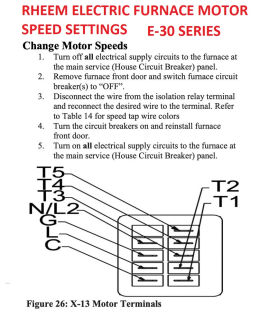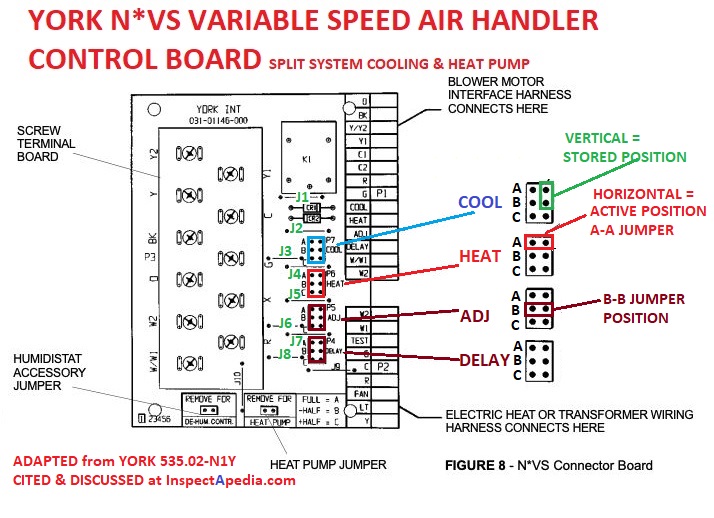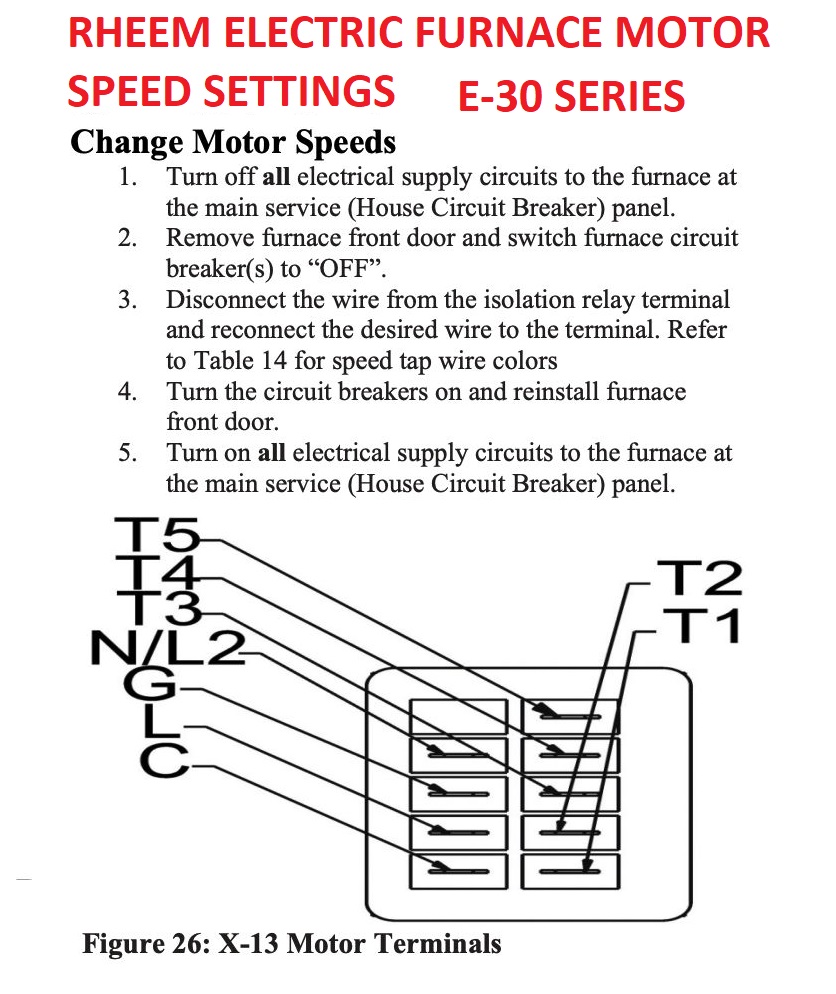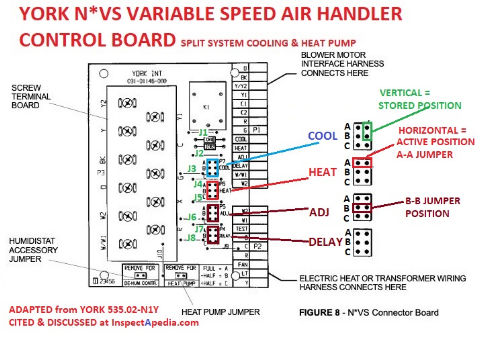 Air Handler Blower Fan Speed
Air Handler Blower Fan Speed
Jumpers / Switches / Controls for Fan Speeds & Functions
- POST a QUESTION or COMMENT about how to diagnose & repair problems with the air handler or blower unit / fan assembly in a warm air furnace or air conditioning system
How is the blower fan or air handler fan speed controlled in heating and air conditioning air handler equipment or split systems air AHUs?
This article series explains how to inspect & repair the indoor components of air conditioners and heat pumps: the air conditioning system indoor air handler units, blower units, or AHU's, (also called fan coil units) including the air conditioner blower fan, the indoor cooling coil or "evaporator coil", air conditioning system filters, and the causes, cures, and prevention of air handler leaks that lead to rust, damage, and mold contamination in the air conditioning system.
InspectAPedia tolerates no conflicts of interest. We have no relationship with advertisers, products, or services discussed at this website.
- Daniel Friedman, Publisher/Editor/Author - See WHO ARE WE?
Air Handling Unit Blower Fan Speed Adjustment
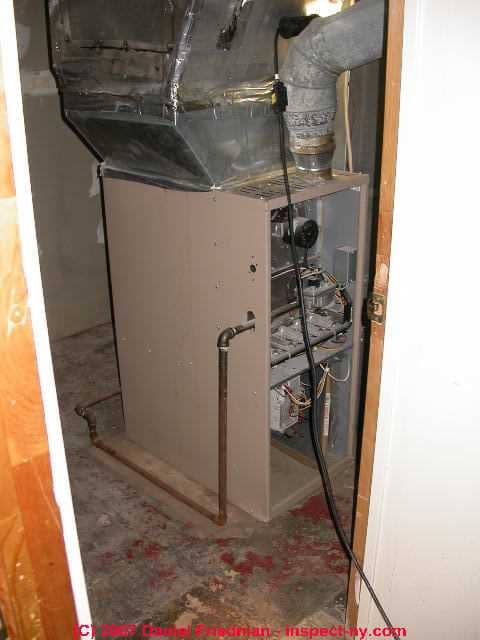 This article describes using jumpers or switch settings or independent controls to adjust the blower fan speed in air handlers used in heating and cooling systems.
This article describes using jumpers or switch settings or independent controls to adjust the blower fan speed in air handlers used in heating and cooling systems.
There is no single "right" fan speed for all heating and cooling conditions and both high and low speed settings have uses and advantages.
[Click to enlarge any image]
At RETURN AIR, INCREASE we explained that in general,
Higher air speeds are needed during the cooling season than during the heating season.
In general, higher air handler unit (AHU) speeds when running in cooling mode will give quicker cool-down of the occupied space and are suitable during daylight hours when the cooling load will be highest. Higher fan speeds may actdually be more energy-efficient as well. (Khattar un-dated).
Conversely we use a lower fan speed during cooling season to increase the dehumidification or moisture removal in the building, and for night-time operation when the cooling load is reduced. The result is a more-quiet cooling system operation.
Blower Fan Speed Adjustment Options
Fan speeds provided inside the air handler unit may be set or adjusted by
- The remote control for a wall-mounted split system air conditioner or heat pump
- Changing the fan wire connection between the fan-on relay and the fan motor, selecting a high, medium, or low speed right on the fan motor itself
- Changing jumper positions on the control board (printed circuit board shown below) in the air handler
- Changing a dip switch or small slider switch position provided on some air handler control boards
- Changing a fan speed (ON AUTO OFF HI LO) provided on some room thermostats
Blower Fan Wire Color Codes
Typical fan wire colors in an air handler or at the blower motor will be (not all of these are always present):
- White: common / neutral
- Black: high fan speed power lead
- Blue: medium-high fan speed power lead
- Orange: medium fan speed power lead
- Red: low fan speed power lead
An ohmmeter checking between common (white) and other wires can compare circuit resistance: highest resistance = lowest speed.
Watch out: do not even touch wires or the control board if you are not trained in safe electrical work as you could be shocked or killed.
Be sure to see the wiring diagram on the fan motor and/or on or in the air handler unit itself as well as in the manual.
You've got the manual, right? If not we give a link below for finding manuals for most HVAC equipment.
Read the instructions for your specific air conditioner or heat pump air hander and fan speed control settings as provided by the manufaturer as those will give you actual anticipated air flow rates in CFM (Cubic Feet per Minute) as well as the proper fan speed settings for different conditions or objectives.
Watch out: before changing your blower fan to a higher speed to address air flow that is too weak, make sure that the problem isn't something more basic such as a dirty blower fan, leaky or crushed air ducts, or a dirt or ice-blocked cooling coil or heating coil (for heat pumps).
See those diagnostics
Question: how do I change the speed on my Rheem air handler?
Rheem air handler runs too slow when A.C. is on , but runs way fast when furnace is on. wiring must not be correct, am thinking I need to switch 2 wires , am I correct ? and which wires
Reply:
Below we include links for installing and wiring and setting switches on some Rheem air handler units. First let's review a general explanation of how we set the fan speed in HVAC systems.
Most modern heating & cooling air handlers that move air through duct systems for both heating and cooling will have a fan that can run at different speeds or even continuously-variable speed.
Inside the air handler, usually on a control board (a printed circuit board) there will be one or more switches or little jumpers that the service technician can set to control the fan speed or speeds on the particular air handler. It's usually a switch or jumper change, or occasionally on older air handlers, moving a wire from one pin to another.
We need to know the brand and model of your air handler, then to look at the installation and service manual for it (those are available free as PDF downloads here at InspectApedia.com) to see exactly how fan speed is adjusted for your specific machine.
Common air handler fan speeds might be labeled on the circuit board as simply A B C that enables you to move a jumper to connect pairs of pins at each of those locations to select the given fan speed or fan feature.
[Click to enlarge any image]
In the example circuit board diagram shown below, from a York variable speed fan instruction manual (given below) you can see the basics of how jumpers are used to join pairs of pins to set various features provided by the manufacturer.
On some other air handler circuit boards you may see the fan speed options labeled like this:
- Hi Cool - highest fan speed setting used during cooling
- Hi Heat - highest fan speed setting for heating
- VsG - 50% of Hi Cool speed - may be used for dehumidification only
- Lo Heat - lower speed for heating at lower loads
- Lo Cool - lower speed for cooling, again at lower loads
And of course on a typical split system heat-pump / cooling unit the remote control will offer additional user control such as a variable fan speed or a very low speed "dehumidification" fan setting.
Low Fan Speed for Dehumidification
Why that very low speed? By slowing the air movement through the cooling coil the system will remove more moisture from humid air than would occur if the blower moves faster because the faster air movement more quickly cools the room down and thus reaches the set temperature on the thermostat. In other words to dehumidify we may need to run the system for a longer time.
See those details at DEHUMIDIFICATION PROBLEMS
In the SPECIFIC INSTRUCTIONS for your air handler you'll see how fan speed should be set: most-often you simply move a jumper between pairs of pins. The instructions will also tell you the actual fan speed in CFM (cubic feet per minute) that your air handler will produce at each setting and the instructions will include a table that guides you in selecting the right fan speed settings.
The schematic I will attach below illustrates fan speed settings for a York Variable Speed air handler NV*S blower.
The instructions for that air handler can be downloaded at inspectapedia.com/aircond/York-Variable-Speed-Air-Handler-Instructions.PDF
Watch out: do NOT try to follow example fan speed setting instructions unless they match your particular brand and model air handler.
Watch out: running the blower speed too fast during air conditioning may result in inadequate dehumidification, while running the fan at too-slow a speed may result in ice blockage on the cooling coil.
Those details are at
FROST BUILD-UP on AIR CONDITIONER COILS
HVAC Blower Fan Installation & Fan Speed Setting Guides
- MANUALS & PARTS GUIDES - HVAC - home - complete set for all brands and manufacturers: download PDFs
- Alpine STANDARD AC FURNACE CONTROL WIRING [PDF] Alpine Home Air Products, TEl: 1-800-865-5931 Website: www.alpinehomeair.com retrieved 2019/11/13 original source: https://www.alpinehomeair.com/related/Standard%20AC%20Wiring%20Diagrams%20.pdf
- Bryant FAN COIL UNIT SERVICE MANUAL [PDF] retrieved 2019/11/13, original source: https://www.utcccs-cdn.com/hvac/docs/1009/Public/0A/SM03-3.pdf
- Carrier RESIDENTIAL FAN COIL UNITS FB-FM [PDF] (2018) retrieved 2019/11/13, original source: https://resource.carrierenterprise.com/is/content/Watscocom/carrier_fb4cnf048l00_article_1391689355743_en_sm
- Enertech Geothermal MPD MPH MORTEX AIR HANDLER INSTALLATION & MAINTENANCE MANUAL [PDF] retrieved 2019/11/13, original source: http://commercial.tetcogeo.com/series/literature/20D282-01NN
- Johnson Controls MODULAR VARIABLE SPEED AIR HANDLERS MANUAL Models MV [PDF] (2010) Johnson Controls Unitary Products 5005 York Drive Norman, OK 73069
- Khattar, Mukesh, AIR CONDITIONER FAN SPEED CONTROLLER for COMFORT & DEHUMIDIFICATION [PDF] Florida Solar Energy Center/University of Central Florida 1679 Clearlake Road, Cocoa, Florida 32922, USA retrieved 2019/11/13 original source: http://www.fsec.ucf.edu/en/publications/pdf/FSEC-FS-31-85.pdf
Excerpt:
The blower fan motor in most air conditioners has three speed settings - low, medium and high. In the factory, the fan is unsually set at medium speed, but another speed may be selected during installation. User selection of fan speeds on a day-to-day basis is not available.
Caution must be exercised in selecting speeds lower than manufacturer's recommendation. It might cause frosting on the coil.
Adjusting the fan speed during air conditioner operation can offer several advantages from the standpoints of comfort, humidity control and energy consumption. The fan speed can simply be switched manually or with a special controller. - Khattar, Mukesh, and Hugh I. Henderson Jr. "Impact of HVAC control improvements on supermarket humidity levels." ASHRAE Transactions 105 (1999): 521.
- Lennox Signature® Collection CBX40UHV AIR HANDLER UNIT MANUAL [PDF] (2016) Lennox Industries, Dallas TX USA retrieved 2019/11/13, original source: https://resources.lennox.com/fileuploads/a1cfea55-845e-427e-ab0d-57bbcfecd3e5Lennox_CBX40UHV_IOM.pdf
- RHEEM RHML AIR HANDLER MANUAL [PDF] US: Rheem Heating, Cooling & Water Heating • P.O. Box 17010
Fort Smith, Arkansas 72917 • www.rheem.com
Canada: Rheem Canada Ltd./Ltée • 125 Edgeware Road, Unit 1 Brampton, Ontario • L6Y 0P5 - RHEEM AIR HANDLER INSTALLATION INSTRUCTIONS H1T H2T [PDF] Rheem, Website: https://my.rheem.com/ retrieved 2019/11/13 original source: http://pts.myrheem.com/docstore/webdocs/Public/ServicePublic/Trouble2a/pdfs/Airhand/H1T/92-20521-66-06_H1T_H2T.pdf
- RHEEM AIR HANDLER INSTALLATION INSTRUCTIONS H1V H2V [PDF] retrieved 2019/11/13 original source: http://pts.myrheem.com/docstore/webdocs/Public/ServicePublic/Trouble2a/pdfs/Airhand/H1V/RH1V_RH2V_92-20521-65_Rev_3.pdf
Above: with POWER OFF Rheem explains how to change the wire positions to change the blower motor speeds on Rheem E30 series furnaces.
- RHEEM 1 & 2-Stage ELECTRIC FURNACE E30 INSTALLATION [PDF] Model E30 Series retrieved 2019/11/13
Includes wire color codes for heating & cooling thermostats and hookups and the procedure for changing the motor speed on p. 17 and shown above. - RHEEM STANDARD EFFICIENCY AIR HANDLER RH1P RH1Q SERIES MANUAL [PDF] retrieved 2019/11/13, original source: https://resource.gemaire.com/is/content/Watscocom/Gemaire/rheem_rh1p1817stanja_article_1399041970729_en_ss.pdf?fmt=pdf
- Unico System S.M.A.R.T. CONTROL
BOARD (SCB)
INSTALLATION
INSTRUCTIONS [PDF] (2018) Unico Systems, 1120 Intagliata Drive
Arnold, MO 63010
USA Tel: (800) 527-0896
Excerpt: ... information to properly install the Unico software managed air flow rate and temperature S.M.A.R.T.1 control board (SCB). The SCB control board is available as part of the blower assembly or as part of retrofit kit that includes the motor and blower wheel. - York VARIABLE SPEED AIR HANDLER N*VS BLOWER INSTALLATION MANUAL [PDF] York Heating and Air Conditioning, P.O. Box 1592, York, Pennsylvania USA 17405-1592 retrieved 2019/11/13, original source: http://upgnet.com/Site/InformationCenter/York/Archive_CDs/York_1995/PUB/53503/OUT/N1Y.PDF
- York VARIABLE SPEED AIR HANDLER BLOWER SPEED SELECTION TABLE [PDF] for York N*VS & F*FV Series Variable Speed Air Handlers, (2005) Unitary Products Group, York International, PO Box 19014, Wichita KS 67204-9014 retrieved 2019/11/13 original source http://www.upgnet.com/PdfFileRedirect/128002-UMM-B-0405.pdf
...
Continue reading at BLOWER FAN OPERATION & TESTING or select a topic from the closely-related articles below, or see the complete ARTICLE INDEX.
Or see these
HVAC Blower Fan Articles
- AIR HANDLER / BLOWER UNITS - home
- AIR HANDLER BLOWER DOORS
- AIR FLOW TOO WEAK
- BLOWER DOOR SAFETY SWITCH
- BLOWER FAN ASSEMBLY CLEANING
- BLOWER FAN OPERATION & TESTING
- BLOWER FAN SPEED SETTINGS
- BLOWER LEAKS, RUST & MOLD
- DEHUMIDIFICATION PROBLEMS
- DIRTY A/C BLOWERS
- FAN, AIR HANDLER BLOWER UNIT
- FAN, COMPRESSOR / CONDENSER UNIT
- FAN LIMIT SWITCH INSTALLATION & WIRING
- FAN LIMIT SWITCH TROUBLESHOOTING
- FAN MOTOR START CAPACITORS
- FAN NOISES, HVAC
- FAN ON AUTO MAN THERMOSTAT SWITCH
- FAN WONT STOP - THERMOSTAT SWITCH
- FROST BUILD-UP on AIR CONDITIONER COILS
- MANUALS & PARTS GUIDES - HVAC - home
- RETURN AIR, INCREASE
Suggested citation for this web page
BLOWER FAN SPEED SETTINGS at InspectApedia.com - online encyclopedia of building & environmental inspection, testing, diagnosis, repair, & problem prevention advice.
Or see this
INDEX to RELATED ARTICLES: ARTICLE INDEX to AIR CONDITIONING & HEAT PUMPS
Or use the SEARCH BOX found below to Ask a Question or Search InspectApedia
Ask a Question or Search InspectApedia
Try the search box just below, or if you prefer, post a question or comment in the Comments box below and we will respond promptly.
Search the InspectApedia website
Note: appearance of your Comment below may be delayed: if your comment contains an image, photograph, web link, or text that looks to the software as if it might be a web link, your posting will appear after it has been approved by a moderator. Apologies for the delay.
Only one image can be added per comment but you can post as many comments, and therefore images, as you like.
You will not receive a notification when a response to your question has been posted.
Please bookmark this page to make it easy for you to check back for our response.
IF above you see "Comment Form is loading comments..." then COMMENT BOX - countable.ca / bawkbox.com IS NOT WORKING.
In any case you are welcome to send an email directly to us at InspectApedia.com at editor@inspectApedia.com
We'll reply to you directly. Please help us help you by noting, in your email, the URL of the InspectApedia page where you wanted to comment.
Citations & References
In addition to any citations in the article above, a full list is available on request.
- Thanks to Mark Cramer, Tampa Florida, for assistance in technical review of the "Critical Defects" section and for the photograph of the deteriorating gray Owens Corning flex duct in a hot attic. Mr. Cramer is a Florida home inspector and home inspection educator.
- Thanks to Jon Bolton, an ASHI, FABI, and otherwise certified Florida home inspector who provided photos of failing Goodman gray flex duct in a hot attic.
- Wikipedia provided background information about the definition of HEPA and airborne particle interception.
- [5] US EPA - Mold Remediation in Schools and Commercial Building [ copy on file as /sickhouse/EPA_Mold_Remediation_in_Schools.pdf ] - US EPA
- Modern Refrigeration and Air Conditioning, A. D. Althouse, C.H. Turnquist, A. Bracciano, Goodheart-Willcox Co., 1982
- Principles of Refrigeration, R. Warren Marsh, C. Thomas Olivo, Delmar Publishers, 1979
- "Air Conditioning & Refrigeration I & II", BOCES Education, Warren Hilliard (instructor), Poughkeepsie, New York, May - July 1982, [classroom notes from air conditioning and refrigeration maintenance and repair course attended by the website author]
- Refrigeration and Air Conditioning Technology, 5th Ed., William C. Whitman, William M. Johnson, John Tomczyk, Cengage Learning, 2005, ISBN 1401837654, 9781401837655 1324 pages
- Our recommended books about building & mechanical systems design, inspection, problem diagnosis, and repair, and about indoor environment and IAQ testing, diagnosis, and cleanup are at the InspectAPedia Bookstore. Also see our Book Reviews - InspectAPedia.
- Complete List of Air Conditioning & Heat Pump Design, Inspection, Repair Books at the InspectAPedia Bookstore.
- In addition to citations & references found in this article, see the research citations given at the end of the related articles found at our suggested
CONTINUE READING or RECOMMENDED ARTICLES.
- Carson, Dunlop & Associates Ltd., 120 Carlton Street Suite 407, Toronto ON M5A 4K2. Tel: (416) 964-9415 1-800-268-7070 Email: info@carsondunlop.com. Alan Carson is a past president of ASHI, the American Society of Home Inspectors.
Thanks to Alan Carson and Bob Dunlop, for permission for InspectAPedia to use text excerpts from The HOME REFERENCE BOOK - the Encyclopedia of Homes and to use illustrations from The ILLUSTRATED HOME .
Carson Dunlop Associates provides extensive home inspection education and report writing material. In gratitude we provide links to tsome Carson Dunlop Associates products and services.


